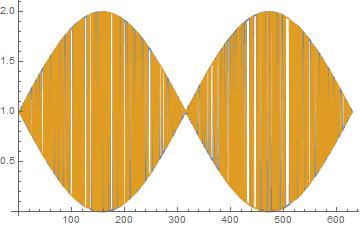I had to run NSolve to solve a nonpolinomial equation (it has some square roots in it) to get roots of the equation. I've got a solution that looks something like this (see myrootsSolution).

The equation is too big to be posted here, so I run code that simulates the roots solution. When you look at the plot of myrootsSolution, it is obvious that the roots have sinusoidal properties. Other thing is that points oscillate between two sines so that I cannot use the ListLinePlot or do other calculations. I think I can fix that problem by chopping the data in half and swapping the same way I created this data. Unless someone knows a better way. But how about the oscillating points? The code below simulates my roots solution:
Remove["Global`*"];
ClearAll;
max=6;steps=0.1
x=Range[0,max,steps];
y=0.05*Sin[x]+0.1;
ListPlot[y,PlotRange->{-0.2,0.2}]
w=-0.05*Sin[x]+0.1;
ListPlot[w,PlotRange->{-0.2,0.2}]
z = RandomInteger[1, max/steps + 1];
y1 = (-1)^z*y;
ListPlot[y1]
w1 = (-1)^z*w;
otherCase = ListPlot[w1]
n1 = List[y1, w1];
shouldBe = ListPlot[n1] (* but still noisy*)
p1=Take[y1,(max)/(2*steps)];
p2=Take[y1,-(max)/(2*steps)];
p3=Take[w1,(max)/(2*steps)];
p4=Take[w1,-(max)/(2*steps)];
j1=Join[p1,p4];j2=Join[p2,p3];
j3=List[j1,j2];
myRootsSolution=ListPlot[{j1,j2}] (* this is what I get from NSolve *)
f1 = 0.05*Sin[x] + 0.1;
f2 = 0.05*Sin[x] - 0.1;
f3 = -0.05*Sin[x] + 0.1;
f4 = -0.05*Sin[x] - 0.1;
ideally = ListLinePlot[{f1, f2, f3, f4}]
In other cases, the roots solution is simple but still noisy; see othercase:

My goal is to sort the data points to get something ideal as shown here:
I don't think we can tell NSolve how to sort roots unless I am missing something. Do you know how to sort myRootsSolution data automatically (so that I can continue calculations with it) instead doing manual work like I can do by doing the reverse of creating those data. (note that NSolve finds all the roots).
Again, Below is my update to this question. I have made an attempt to automate this. I folded in half along the x-axis because both are symmetrical in y-axis always. So I ended up with two sine waves in the positive y-axis. My trick is to take the derivative of roots. If sine waves are separated the derivative should be a smooth cosine. If sine waves are crossing each other then the derivative is jerking at the crossing point. Since I don't have FindPeaks because Mathwolf v9, I have to find one. I am using those crossing points to determine from where should I flip the other half of the curves. See my code below of my attempt:
ClearAll;
max=6;steps=0.05;
x=Range[0,max,steps];
z=RandomInteger[1,Length[x]];
f1=0.05*Sin[x]+0.1;
f2=0.05*Sin[x]-0.1;
f3=-0.05*Sin[x]+0.1;
f4=-0.05*Sin[x]-0.1;
ideally=ListLinePlot[{f1,f2,f3,f4}]
ph=0.1;offs=0.1;
e1=(Abs[0.05*Sin[x+ph]]+offs)*(-1)^z;
e2=(Abs[0.05*Sin[x+ph]]-offs)*(-1)^z;
e3=(-Abs[0.05*Sin[x+ph]]+offs)*(-1)^(z);
e4=(-Abs[0.05*Sin[x+ph]]-offs)*(-1)^(z);
e5={e1,e2,e3,e4};
roots=Transpose[{e1,e2,e3,e4}];
ListPlot[e5,PlotRange->{-0.2,0.2}]
roots1=Abs[roots];
ListPlot[Transpose@roots1,PlotRange->{-0.2,0.2}]
size=Dimensions[roots1];
columns=Part[size,2];
column=Range[columns/2+1,columns,1];
roots2=Part[roots1,All,{1,2}];
ListPlot[Transpose@roots2,PlotRange->{-0.2,0.2}]
dy3=With[{pad=IntegerPart[max/steps]- 1},ArrayPad[DerivativeFilter[ArrayPad[roots2,pad,"Extrapolated"],{1}],-pad]];
test3=dy3;
minD=(-MinDetect@test3);
maxD= (MaxDetect@test3);
fig1=ListLinePlot[Transpose@dy3,DataRange->{0,6}]
fig2=ListPlot[0.003*Transpose@maxD,DataRange-> {0,6},PlotStyle->PointSize[0.02],PlotRange->{-0.004,0.004}]
fig3=ListPlot[0.003*Transpose@minD,DataRange-> {0,6},PlotStyle->PointSize[0.02],PlotRange->{-0.004,0.004}]
y=0.05*Sin[x]+0.1;
w=-0.05*Sin[x]+0.1;
ftest=List[y,w];
minD1=0.15*(-MinDetect@ftest)+0.2;
maxD1= 0.15*(MaxDetect@ftest);
fig4=ListLinePlot[ftest,DataRange->{0,6}]
fig5=ListPlot[maxD1,DataRange-> {0,6},PlotStyle->PointSize[0.02],PlotRange->{-.17,.17}]
fig6=ListPlot[minD1,DataRange-> {0,6},PlotStyle->PointSize[0.02],PlotRange->{-.17,.17}]
Show[fig1,fig2,fig3]
Show[fig4,fig5,fig6]
minx=x*Abs[minD];
maxx=x*Abs[maxD];
coord=List[{minx},{maxx}];
Transpose@coord;
By looking at the derivatives, I know the top one changes from minimum to maximum in one step, and the bottom one changes from maximum to minimum both at crossing points. The problem I have is that the crossing point is not exactly and I have to narrow it down and then use those points to select halfs of sine to flip mirror so that I get original sine waves as shown in ideal variable.

I also add code that shows why NSolver makes this kind of graph. I called the equation blackbox because actual equation is too complex and long for posting. But end result is very similar. Is there a way to modify NSolve code to fix this? Something like derivative roots?
Remove["Global`*"];//Quiet
ClearAll;
blackbox[a_]=(x-Sin[a]-1)*(x-Sin[a-Pi]-1)
(-1+x-Sin[a]) (-1+x+Sin[a])
xx=Range[0,2*Pi,0.01];
roots=Table[x/.NSolve[blackbox[b]==0,x],{b,xx}];
ListPlot[Transpose@roots]
Thanks in advance,













xvalues that give close numeric derivatives to prior such values. Perhaps better would be to start with one solution set and change the problem to one of solving a system of ODEs, in effect tracking the solution sets. $\endgroup$